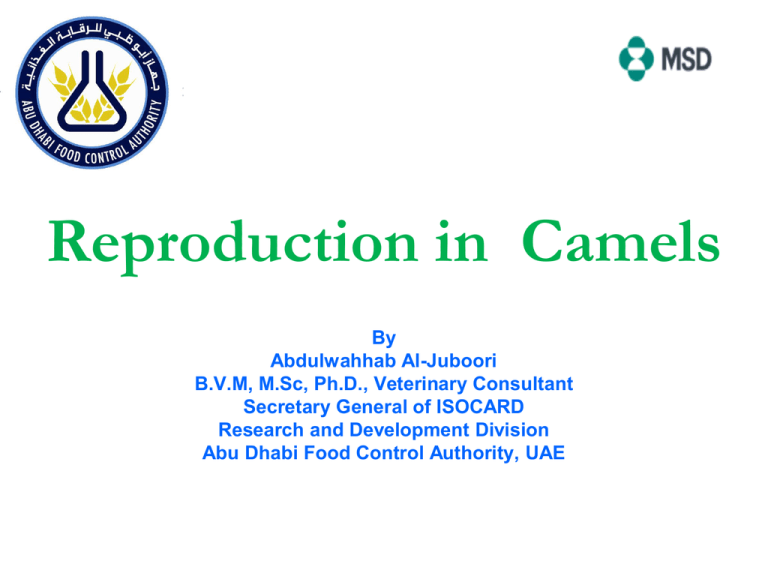
Reproduction in Camels
By
Abdulwahhab Al-Juboori
B.V.M, M.Sc, Ph.D., Veterinary Consultant
Secretary General of ISOCARD
Research and Development Division
Abu Dhabi Food Control Authority, UAE
• Introduction
• Reproductive Anatomy of Male and
Female Camel
• Reproductive Physiology of Male and
Female Camel
• Common Reproductive Disorders
Introduction
• Camels known as the “SHIP OF THE DESERT”
• Camel (Camelus dromedarius) is an important multipurpose
livestock species uniquely adapted to harsh arid and semi-arid areas
that can be used for meat, milk, wool, and hide production and
transportation.
• Now it is has become a source of entertainment, celebration and
competition.
• There are 24,246,291 million one-humped camels in the world with
80% of them in Africa and the highest population in Somalia (7
million) and Sudan (4.25 million). In Asia about 70% of dromedaries
are found in India and Pakistan.
• The value of the camel has been realized recently in two major areas,
firstly as a good source for human food in areas where traditional
livestock would not thrive, secondly in the areas of racing sport and
beauty show. A good racing or beauty camel in the Gulf area could
fetch as three to four million dollars.
Introduction
•
The reproductive efficiency of camels under natural conditions is generally regarded to
be low. This probably due to
•
•
•
•
•
•
•
•
Short breeding season,
Longer prepubertal period,
Long gestation period of 13 months,
Delayed puberty,
Prolonged (8–10 months) period of lactation,
Poor pastoral management systems,
Inadequate nutrition and
The lack of use of assisted reproductive techniques such as embryo transfer and
artificial insemination .
•
Camel is a seasonal breeder and their reproduction is different as compared to other
livestock as both male and female come into heat during the breeding season.
Reproduction Anatomy in Male Camels
Scrotum and Testes :
•
•
•
•
•
•
The scrotum is located in the perineal region.
The scrotal skin tends to be smooth during the breeding season and becomes thicker during the
period of sexual inactivity because of decreased testicular size.
The testes are ovoid in shape and are usually descended at birth but are very small.
Its vary in length from 7 - 10 cm and weigh between 80 - 100 g each.
They become enlarged and protrude when the male camels are sexually active in the rutting season.
The right testicle is often slightly smaller than the left one.
Tibary and Anouassi 1997)
Reproduction Anatomy in Male Camels
Seminiferous tubules:
•
The outer diameter is between 113 – 250 mm in diameter and gets significantly smaller during the
non-rutting season. The estimated production of spermatozoa is 8.1 x 106 sperm cells per day at the
end of Spring and drops to 4.2 x 106 sperm cells per day at the end of the Summer.
•
The number of spermatozoa per gram of testicular tissue varies from about 27 – 30 million in calm
males to 36 – 47 million during rut.
Epididymis:
•
The epididymis is composed of three distinct parts: the head, body and tail. It is located along the
dorsal border of the testis with the head curving around the cranial pole of the testis.
•
The tail is round and well-protruded about 3 - 4 cm above the respective extremity of the testis.
Ductus deferens:
•
The ductus (or vas) deferens are very long measuring between 45 - 50 cm in length and are enclosed
within the spermatic cord.
Tibary and Anouassi 1997)
Reproduction Anatomy in Male Camels
Prepuce and penis:
•
The prepuce is pendulous, flattened from side to side and triangular structure that is facing back.
Thus, urine is passing backward. It is formed by two layers, parietal and visceral. Between these two
layer, three group of muscles. Due to the action of these muscles, the prepuce can move cranially
and caudally during erection or urination. These muscles also control dilation and constriction of the
preputial orifice.
Tibary and Anouassi 1997)
•
The penis is composed of fibroelastic tissue, having a prescrotal sigmoid flexure that is located in
front of the scrotum but not behind as in bovine bull.
•
The length of the penis ranges from 59 - 68 cm and it is cylindrical in shape.
Reproduction Anatomy in Male Camels
•
A retractor penis muscle is present and attaches to the distal part of the sigmoid flexure which help
in directing the penis forward during erection for copulation.
•
The glans penis 8-12 cm long and ends in a cartilaginous process which directs the penis into the
cervix of the female during copulation. The glans penis is curved along its vertical plane giving it a
hook-shape with a definite neck between the glans and body of the penis.
•
The cranial end of the penis is twisted and the terminal process is cartilaginous and directed to the
left and dorsally in a T shape.
Tibary and Anouassi 1997)
Tibary and Anouassi 1997)
Gahlot 2000
Reproduction Anatomy in Male Camels
Accessory sex glands:
•
The Prostate Gland: This is the largest and only palpable gland in the dromedary. It has two
components, a compact and a diffuse part, the two forming an H shape which lies dorsal to the pelvic
urethra. It averages, 3–7 × 5 cm and is dark yellow in color.
•
The Bulbourethral glands (Cowper’s gland): There are two bulbourethral glands which are almond
shaped structures that are located on either side of the terminal portions of the pelvic urethra. it
measure about 1.2-2.5 cm.
Tibary and Anouassi 1997)
Gahlot 2000
•
Poll glands: Male camels have two tubulo-alveolar glands (poll glands) in the occipital region between
the two ears on the back of the neck. In the period when the testosterone levels are high there is a
copious secretion from the occipital gland. The secretion is dark brown and has an acrid smell. The
main function of these secretions is making territory and attracting females.
•
There are no seminal vesicles in the camels.
Reproduction Anatomy in Male Camels
•
•
•
The Ampulla: The initial part of the ductus deferens is small in diameter and very tortuous but it
thickens and forms the ampulla as it approaches the pelvic urethra. It averages 18 cm in length with
the terminal part embedded in a deep groove located on the ventral surface of the corpus
prostatae. It has been suggested that these glands may play the role of a sperm reserve before
ejaculation.
The Urethral Glands: These are located just behind the body of the prostate and extend to the level
of the urethral bulb before opening into the urethral lumen via numerous ducts. These glands and
the pelvic urethra are richly enervated; these nerves being responsible for the contraction of the
muscle and expulsion of glandular secretion.
Tibary and Anouassi 1997)
Reproduction Anatomy in Females Camels
The Ovary:
•
The ovaries are located about 36 cm from the opening of the vulva but are subject to great variations
depending on the physiological stage. For example, during pregnancy they becomes more ventral and
are pulled forward during the advancing stages thus making them very difficult to palpate.
•
The left ovary is generally more cranio-ventral in position than the right ovary.
•
Their general appearance and size varies according to the age and activity of the animal. In the
prepubertal animals they have a smooth and glistening surface with several raised small vesicles (2 5 mm in diameter) throughout the surface which correspond to the follicles. In anoestrous and
nulliparous females the ovaries are oval or circular, flattened laterally and have an irregular surface
due to many small follicles. During the breeding season, mature follicles and current copora lutea
(CL) project from the main contour of the ovary and give it a more lobular form.
•
The measurements given for the ovary vary from 2.6 - 6 cm in length, 2 - 4 cm in width and 0.5 - 0.9 cm
in thickness and each ovary weighs between 3 - 4g in dromedaries. However, they increase in weight
with increasing age, ovarian activity and during pregnancy, as during pregnancy they are bearing the
CL.
Tibary and Anouassi 1997)
Reproduction Anatomy in Females Camels
•
Follicles: Follicular activity is dominated by 4 types of follicles, namely: small growing follicles,
mature follicles, regressing follicles or over-large, anovulatory follicles. As the follicular waves
overlap with each other, several generations of follicles may be present at the same time. The
small growing follicles are visible on the surface of the ovary as small slightly raised vesicles
measuring between 2 - 4 mm, whereas the mature pre-ovulatory follicle measures between 13 – 20
mm and is spherical, turgid, with a thin clear translucent wall and protrudes markedly from the
ovarian surface.
Tibary and Anouassi 1997)
•
The appearance of regressing follicles depends on the stage of regression. At the start of
regression the follicular wall becomes thick and opaque and the diameter decreases slowly until
the follicle recedes into the ovary itself. Large anovulatory follicles are present in about 50% of
non-mated females and their size and appearance can be highly variable.
•
They vary in size from 25 - 60 mm and may have a thin or thick, opaque wall and contain either
serous or haemorrhages fluid with various amounts of fibrin.
Reproduction Anatomy in Females Camels
•
Corpus Luteum: The corpus luteum forms after ovulation, which occurs 24 - 48 hours after mating.
The ovulating follicle collapses at ovulation and then the follicular cavity fills with blood to form a
corpus haemorrhagicum. Luteinization of the corpus haemorrhagicum occurs within 4 - 5 days and
gives rise to a corpus luteum. In the non-pregnant camel the CL measures 12 - 15 mm in diameter and
weighs 1.5 - 2 g, but during pregnancy the size and weight increases to an average of 22 + 6 mm and
4.9 + 1 g respectively. Regression of the CL occurs between 10 - 12 days after a sterile mating or just
before parturition in the pregnant camel. The corpus albicans, originating from the regression of the
CL of pregnancy is hard, white or grey in color and has no blood vessels on its surface. Corpora
albicantia of different sizes (5 – 12 mm in diameter) can remain on the surface of the ovary of the
female for a long time.
Oviducts:
Tibary and Anouassi 1997)
•
The oviducts measure between 17 - 28 cm in length. The isthmus is less coiled than the ampulla, and
the fimbria lies within the bursa at a short distance from the ovary.
•
Each oviduct opens into the uterine horn via a narrow orifice at the summit of a protuberant papilla
which can be as much as 3 - 5 mm in height. This papillae is very muscular and presents a sphincter
muscle at its apex. The function of this is unknown but it is possible that it plays an important role in
the selective transport of fertilized embryos.
Reproduction Anatomy in Females Camels
Uterus:
•
The uterus is bicornuate with the left horn being distinctly longer than the right. In nulliparous females
the uterus is very small and can be found entirely within the pelvic cavity, whereas in mature nonpregnant females it is located in the abdominal cavity at the level of the 5th, 6th and 7th lumbar
vertebra.
•
The non-gravid uterus has a short body of only 2 - 3.5 cm in length and the horns vary between 6 - 10
cm (right) and 8 - 15 cm (left).
•
The two uterine horns diverge and taper anteriorly to form a T or Y shape with the uterine body of
young or adult females, respectively .
Tibary and Anouassi 1997)
Tibary and Anouassi 1997)
Tibary and Anouassi 1997)
Reproduction Anatomy in Females Camels
The Cervix:
•
•
The cervix has 3 to 4 annular mucosal folds.
The average length and diameter of the cervix during follicular activity is 5 and 6 cm, respectively, but
decreases slightly during the period of ovarian inactivity.
Tibary and Anouassi 1997)
The Vagina:
•
The length of the vagina is 25 - 30 cm. It is lined with many longitudinal folds. The anterior vagina and
the vestibulum are separated by a strong band of tissue (vestibulum sphincter muscle) and the
hymen. This structure is very tight in nulliparous or young animals and can make manual examination
of the vaginal cavity very difficult.
The Vulva:
•
The vulva opens directly below the anus and measures 6 - 7 cm in length. The clitoris is very small
and there is no distinct clitoral fossa. The urethra is also short and the opening of the urinary meatus
is small. The hymen, or its remnants, marks the separation between the vulva and the vagina.
Reproduction Physiology in Male Camels
Puberty
•
The good nutritional and environmental conditions can assist early sexual development
and breeding maturity in dromedary camels.
•
The male camel matures at the age of 3 - 4 years old.
•
The breeding activity starts at 5 years of age.
•
At 6 years of age they are in full reproductive vigour
•
The sexual activity can continues until 20 years of age, but this can vary due to breeds,
genetics, nutrition and climatic changes.
•
The male dromedary can mate with 20 to 50 females a season, when he is in good
condition.
•
In the rutting periods there was increased secretion of androgens (blood, urine and poll
gland).
Reproduction Physiology in Male Camels
Seasonality
•
Seasonality in the male is evidenced by changes in sexual behavior, morphology and
function of the genital organs, as well as changes in endocrinological profiles.
•
The breeding season is very variable but generally coincides with the period of low
humidity, low temperature, and increased rainfall.
•
•
•
In India late September to March,
In Saharan and sub-Saharan regions October to May
In the Middle East late October to late April.
•
The onset of the rutting season can also be affected by the type of management and the
individual male.
•
Males that are loose in a herd tend to come into rut earlier and remain in season for a
longer period than confined males.
Reproduction Physiology in Male Camels
Sexual cycle of the male camel
•
The male camel is a seasonal breeder.
•
The male is normally docile and easily controlled but in the rutting season becomes so aggressive
towards other male camels and humans. The in the rutting seasons shows:
Loss of appetite and kicks.
Protrudes the dulla out side of the mouth, and accompanied by frequent gargling sounds.
Grinds its teeth and large quantities of foam can be seen in the oral cleft.
Reproduction Physiology in Male Camels
•
The hind legs are spread, and the tail is then beaten against the penis.
•
Drops of urine are deposited on the tail and spread over the back.
•
A dark foul smelling substance is secreted from the poll glands.
Reproduction Physiology in Male Camels
Mating
• Generally one stallion can cover 20 to 50 she camels in one season.
• The female sits down and keeps the external genitalia open thus allowing the
male to copulate.
• The whole sexual act takes about 5-20 minutes and is accompanied by gurgling
and frothing by male and bleating by the females.
Reproduction Physiology in Females Camels
Puberty
•
Nutrition, season of birth and breed of camel play an important role in the puberty.
•
Female should be bred when they reach at least 70% of their adult body weight
otherwise abortion rate is increased.
•
In Arabian camels puberty is attained at 2 years of age but in practice females are not
bred until they are 3 or 4 years of age.
Reproduction Physiology in Females Camels
Seasonality
•
Camel is seasonal polyestrous. However, with good nutrition and management, the
female can cycle throughout the year.
•
Arabian camels are best bred from November to March.
•
Breeding of the camels outside of the season leads to high embryonic mortality
•
LH is higher during the breeding season, and the pituitary is more receptive to a
GnRH injection.
Reproduction Physiology in Females Camels
Estrous Behaviour
•
The signs of estrous behaviour in the dromedary as being are
Mounting other females, restlessness, frequent urination,
Swelling of the vulva with a very scanty mucus discharge,
Receptivity to the male,
Moves her tail up and down in rapid succession.
Seeks male and stands besides male.
•
The length of the oestrus cycle is normally 2–3 weeks.
•
The actual heat lasts for 3–4 days.
Tibary and Anouassi 1997)
Reproduction Physiology in Females Camels
Ovulation and Follicular Wave Pattern
•
There is no spontaneous ovulation in the camel. Ovulation in the camel occurs after coitus. Ovulation
occurs 30–48 hours following copulation.
•
Mating with a normal or vasectomized male can produce ovulation.
•
Manual stimulation of the cervix or intrauterine injection of water or the prostaglandin F analogue,
cloprostenol, does not induce ovulation perhaps because these do not stimulate the release of
sufficient LH from the pituitary to cause ovulation.
•
The peak of LH release begins 2 hrs after copulation.
•
Single, i.m. injection of either 20 μg (2.5-10 m) of the GnRH analogue, Buserelin, or 3000 IU human
chorionic gonadotropin (hCG) can induce ovulation.
The waves of follicular growth, maturation and atresia occur throughout the breeding season. Waves
of growing (2-14 days; mean = 6 days), mature (5-19 days; mean = 8 days) and regression (7-10 days;
mean = 8 days). When regression is complete another wave of follicular development starts and follow
the same pattern.
•
The growth rate of the follicles is 0.5-1.0 mm/day.
•
During the follicular phase, basal concentration of LH is 2.7± 1.2 ng/ml. By 4 hour after insemination,
peak values of 6.9 ± 1.0 ng/ml, occur. During follicular phase peripheral plasma progesterone values
are low (0.36 ± 0.28 ng/ml), but values increase to reach 1.73 ± 0.74 ng/ml at 3 days and 2.4 ± 0.86
ng/ml at 7 days after ovulation. The plasma estradiol-17-beta concentrations are 26 ± 9.0 pg/ml during
the follicular phase and 30.8 ± 5.1 pg/ml when the follicle is maximum size.
Reproduction Physiology in Females Camels
Pregnancy
•
The period of gestation is from 365 to 410 days (average 370 days).
•
In camel, 99% of pregnancy occurs in left uterine horn.
•
The incidence of twin ovulation is 14%. Twin births occur to an extent of
only 0.4% when both the ovaries ovulate at the same oestrus.
•
The posterior presentation predominates (54-66%) from early pregnancy, in
camels.
•
Fertilization occurs in the uterine tube and following successful mating, the
CL develops rapidly to achieve its greatest weight and size at 60 days.
•
Fertilization rate reported 82.3% by single mating, which could go up to
100% when animals bred daily for 3 days during estrus.
Reproduction Physiology in Females Camels
Pregnancy
•
The embryo enters the uterus on day 6-7 after ovulation. On the 8th day it is expanded
and hatched from its zona pellucida. On day 10, embryo elongated about 4 mm in length,
on day 12 elongated to 20 mm in length.
•
At 35 days of pregnancy, the fetus can be scanned and extremities can be seen.
•
The heart beats registers earlier (22nd day).
•
Major organs are differentiated during 45-60 days of pregnancy.
•
The amniotic fluid continues to rise steadily up to nearly 1 litter at parturition. Allantoic
fluid increases to up to 6 litters at birth.
•
There is no tendency in late pregnancy for the amnion to separate from the
allantochorion as it may happen in the cows.
•
Reproduction Physiology in Females Camels
Diagnosis of pregnancy:
Bedouin method:
•
On the fourteenth day of post service, the she-camel will be brought to the bull-camel again. If she
refuses to kneel and raise the tail and coil. This would be a strong indication of pregnancy.
However, this response has been noted in unmated animals treated with exogenous progesterone
and also in younger animals that may be alarmed by the male.
Tibary and Anouassi 1997)
Cervical mucous:
•
Mucous during estrus is less viscous, become whitish and scanty in early pregnancy, and difficult
to collect at 2 months of pregnancy.
•
The pH varies between 6.74 and 7.36 during the follicular cycle in non-pregnant camels but it
becomes more alkaline during early pregnancy, increasing from pH 7.05 after mating to as high as
8.2 at the beginning of the sixth week of gestation.
Rectal palpation:
•
This can be done in a sitting position or while standing in a stock.
•
The membrane slip test, described in cattle pregnancy diagnosis, is not possible in Camelidae
because of the diffuse type of placentation. Therefore positive pregnancy diagnosis can only be
achieved if the CL and fetus are palpated.
Reproduction Physiology in Females Camels
Ultrasonography:
•
•
•
•
Early detection of pregnancy occurs at 17 days when small amount of fluid is seen in the
uterine lumen.
The embryo can be seen at 20-21 days.
Heart beats is seen at 22-25 days.
Fetal parts are identified at 55 days.
Progesterone assay:
•
A level of serum progesterone of more than 1.0 ng/ml indicates the presence of CL. If
this level is maintained between 12-15 days, it is more likely that the animal is pregnant.
Chemical test:
•
Cuboni test and Barium chloride test.
Biologic test:
•
Detection of gonadotrophins and vaginal cytology
Reproduction Physiology in Females Camels
Parturition
•
In camels the normal signs of parturition are: Swelling of vulva, Restlessness, Frequent urination,
Camel finds a corner or a dark place and cleans it with the help of fore legs.
•
•
•
Generally, parturition occurs in sitting position.
•
•
•
•
•
•
•
•
•
•
The fore limbs of the young one appear first followed by the head. The duration of the labour is more
pronounced.
Navel cord generally breaks by itself when the camel licks her young and the placenta is expelled
soon after parturition.
Securing of animal as soon as the symptoms are seen is advisable.
The labour pains continue for 5 to 10 hours. She camel remains in recumbent position for few
minutes after parturition.
Camel calf stands on its own within 6-8 hrs after birth.
The female generally produces one calf at a time.
Tibary and Anouassi 1997)
Improving Camel Reproduction
•
Keeping the animals in good body condition
•
Adequate number of males should be kept in the herd
•
Assessment of the male fertility
•
Induction of estrus and management of reproduction
•
Artificial insemination in camels
•
Estrus detection
•
Synchronization of estrus
•
Embryo transfer technology
•
Common Reproductive Disorders in
Dromedary Camels
Prevalence of common various reproductive disorders in camels
No. of camels
examined
No. of camels
found
infected
Prevalence rate (%)
Repeat breeding
321
56
17.45
Uterine prolapse
490
61
12.45
Dystocia
603
56
9.29
Early embryonic death
243
22
9.05
Abortion
543
49
9.02
Retained placenta
458
17
3.71
Uterine torsion
342
13
3.8
Recto-vaginal fistula
342
9
2.63
Udder edema
654
34
5.2
Vaginal prolapse
378
22
5.8
Total
4374
339
7.75
Reproductive disorder
Al-Juboori and Mohammed. 2012. Studies on common reproductive disorders in dromedary camels
(Camelus dromedarius) in UAE under field conditions. Proceeding of the 3rd ISOCARD, Muscat, Oman.
Dystocia
•
Dystocia should be suspected if the first stage or second stages of labor exceeds 6 and 2 hours,
respectively.
•
The animal also shows signs of distress with frequent alteration between standing and sitting
positions, frequent rolling from side to side, and excessive straining.
•
the most common causes of dystocia are the over fat of the dam, lack of exercise, improper breeding
management, fetal malposition, lateral head deviation, feto-pelvic disproportion, vulval or cervical
stenosis, uterine torsion and uterine inertia.
Tibary and Anouassi 1997)
Uterine prolapse
The following factors plays a major role in uterine prolapse
•
Low serum calcium level,
•
Lack of exercise,
•
High intake of green fodder rich in estrogens,
•
An increase in intraabdominal pressure,
•
Excessive relaxation of its pelvic and perineal region due to old age,
•
Selenium deficiency,
•
Feed management,
•
Secondary to dystocia,
•
Manual removal of a retained placenta,
•
Fetal oversize, fetal traction,
•
Excessive obstetrical manipulation,
•
Excessive use of oxytocin and
•
Infection of the uterus following abortion, retained placenta and chronic metritis .
•
Uterine prolapse occurs within the first six hour
after parturition, with an average time of two hour.
Retention of placenta
•
It is failure of placenta to be expelled within normal time (12 hours after birth).
•
The chances of retained placenta increases following dystocia and cesarean section or observed after
normal birth are due to uterine inertia.
•
In our field observations, retained of placenta for more than 48 hours in hot and breeding seasons,
respectively, may lead to developed endometritis.
•
Generally, retention of fetal membranes is rare or uncommon in camels due to the diffuse type of
placenta, although some cases are said to be fatal.
Uterine torsion
•
It is rotation (clockwise or anti clockwise) or displacement of the uterus along its longitudinal axis
during pregnancy as determined by the attending clinician through vaginal palpation, rectal palpation,
or both.
•
The highest prevalence was recorded in the 5th lactation.
•
•
•
•
The possible factors contributing to it may be
Excessive fetal weight,
Loosing of the reproductive organ at older ages and
Increased fetal movements that occur during 1st-stage labor in response to the contraction of the
myometrium.
•
The animals show off fed, congested mucous membrane, tachycardia, and abdominal discomfort
including sitting and rising up and sometimes kicking at the belly and rolling.
•
Most cases of uterine torsion were to the right side (clockwise) and were managed surgically by
caesarian section.
Recto-vaginal fistula
•
Recto-vaginal fistula due to rupture of the dorsal wall of the vagina with the ventral portion of the
terminal rectum.
•
The condition is not very frequent.
•
Out of the 458 camels examined during the present study, 9 camels (2.63%) had recto-vaginal fistula.
•
The present cases were presented with the history of improper handling of fetus during parturition
followed by passage of faeces through vagina and anus.
•
improper handling of fetus, pressure of the fetal forelimb, forceful traction of the fetus during
parturition, rapid vaginal delivery of the fetus without sufficient preparation of the vulva and vestibular
area and complication of fetotomy were the common causes.
Vaginal prolapse
•
Most cases occurred in the 4th to 5th pregnancy, at the end of gestation.
•
The prolapse of vagina can occur during the first half of pregnancy or even in non pregnant animals;
however, the condition is more common during the last 3 months of pregnancy.
•
•
•
•
•
•
•
•
•
•
The cause of vaginal prolapse in camel, such as
Hormonal/metabolic imbalances,
Overfat/overthin body condition,
Bulky feeds,
Older females,
Lack of exercise,
Chronic irritation of the vaginal wall,
Dystocia in previous pregnancies,
Increased abdominal pressure and
Fetal burden.
•
The prolapse can be very little or can be big as up to cervix and visible only in the recumbent female.
However, in advanced or old standing cases the condition persists even in the standing position.
Abortion
•
Abortion in camels was reported to be associated with various pathological conditions such as
brucellosis, trypanosomiasis, toxoplasmosis, campylobacteriosis and salmonellosis.
•
Most the aborted cases occurred during the last trimester of pregnancy.
•
Feeding of the pregnant camels large quantities of green fodder (alfalfa and fescue) during the
trimester of pregnancy may be responsible for abortion in camels.
•
Other less causes of abortion in camels include overworked, twining; hemorrhagic disease, equine
rhinitis A virus, camel pox, endotoxin, excitement, malnutrition, medication and over exertion.
Tibary and Anouassi 1997)
Early embryonic death
•
This phenomena is well known to herdsman.
•
This condition is important constraints hindering reproductive performances of camels, but
difficulty to contain the problem due to their multicausal factors.
•
The reasons for the early embryonic death in camels were due to uterine infections, failure of
corpus luteum to be maintained, failure of conceptus to develop because of bad uterine
environment and abnormalities of corpus luteum function.
Tibary and Anouassi 1997)
Repeat breeding syndrome
•
A “repeat breeder syndrome” is generally defined as any camel that failed to conceive after at least
three regular spaced services, with no clinical abnormalities and associated with true estrus (heat).
•
Repeat breeding is a substantial problem in camels breeding leading to large economic loss for the
camel breeders due to increased calving interval and increased culling rates.
•
Improper management (Inadequate estrous detection, inadequate semen quality, breeding during
hot season, excessive use of male and aged females), Failure of ovulation, and Genital tract
infections were the main causes of repeat breeding in camels.
Thank You For Your Attention
References
•
Abdulwahhab, Yas. 2003. Camels: Diseases & Treatment. First Edition. Amrit Advertising, UAE, ISBN – 9948 – 03
– 059 – 1
•
Al-Ani, F. 2004. Camels: Management and Diseases. First Edition. Dar Ammar Book Publisher.
•
Bravo, B.; Skidmore, J. and Zhao, X. 2000. Reproductive aspects and storage of semen in Camelidae. Animal
Reproduction Science 62, 173–193
•
FAO Corporate Document Repository. 1982. Camels and camel milk. Agricultural and Consumer Protection.
•
FAO Corporate Document Repository. 1994. A manual for primary animal health care worker. Agricultural and
Consumer Protection.
•
Gahlot, T.K. 2000. Selected Topics On CAMELIDS . 1st Edn. .
•
Khanvilkar, A.; Samant, S. and Ambore,B. 2009. Reproduction in Camel. Veterinary World, Vol.2(2): 72-73
•
Manefield, G. and Tinson, A. 1997. Camels, a Compendium. University of Sydney Post Graduate Foundation in
Veterinary Science, Sydney, Australia.
•
Marai1, I; Zeidan, A.; Abdel-Samee, A.; Abizaid, A. Fadiel, A. (2009). Camel’s reproductive and physiological
performance trails as affect by environmental conditions. Tropical and Subtropical Agroecosystems, 10: 129 - 149
•
Mukasa-Mugerwa. 1981. The camel (Camelus dromedarius). A bibliographical review. International Livestock
Center for Africa.
References
•
Skidmore, J. 2005. Reproduction in dromedary camels: an update. Anim. Reprod., v.2, n.3, p.161-171, Jul./Sept.
•
Skidmore, J. 2008. Reproductive Physiology in Male and Female Camels. Vets- Net.Com
•
Skidmore J.A. and Adams G.P. 2000. In: Recent Advances in Camelid Reproduction, Pregnancy Diagnosis in Camels
(17 June 2000). Publisher: International Veterinary Information Service (www.ivis.org)
•
Zafar, I. and Saifuddin, J. 2000. The Camel and its Diseases. Al Bayan Press. Printing and Publishing Est.

![KaraCamelprojectpowerpoint[1]](http://s2.studylib.net/store/data/005412772_1-3c0b5a5d2bb8cf50b8ecc63198ba77bd-300x300.png)








